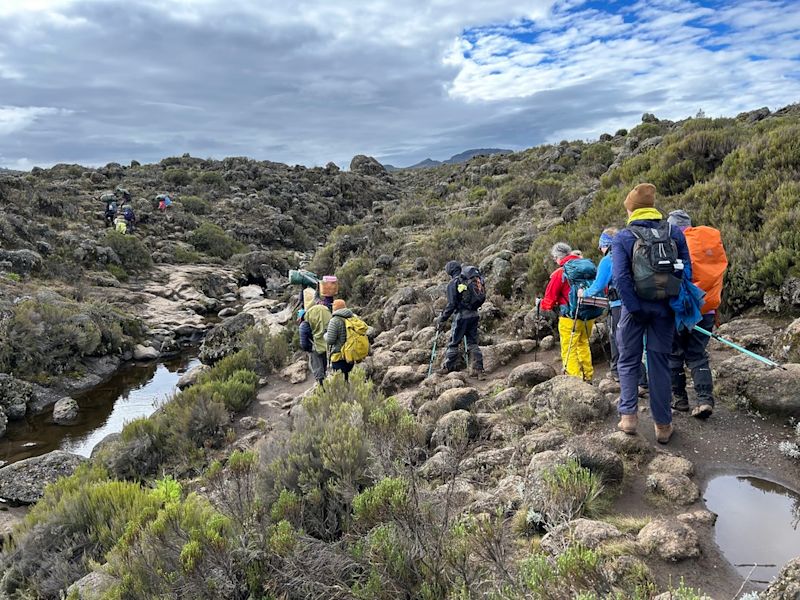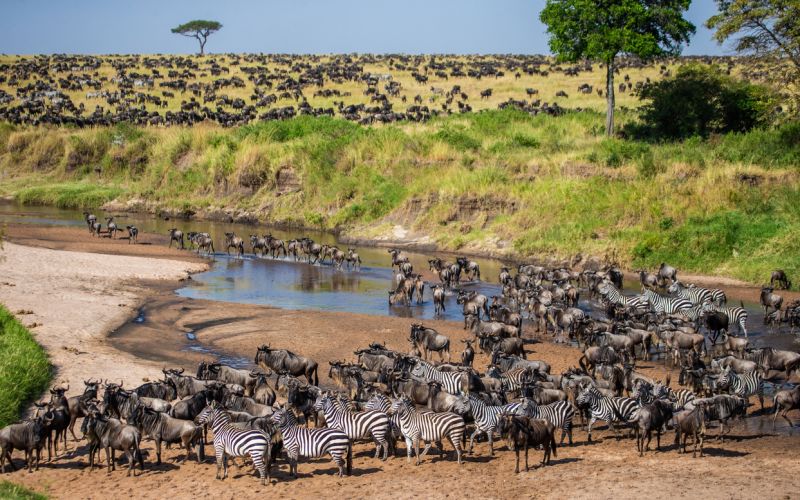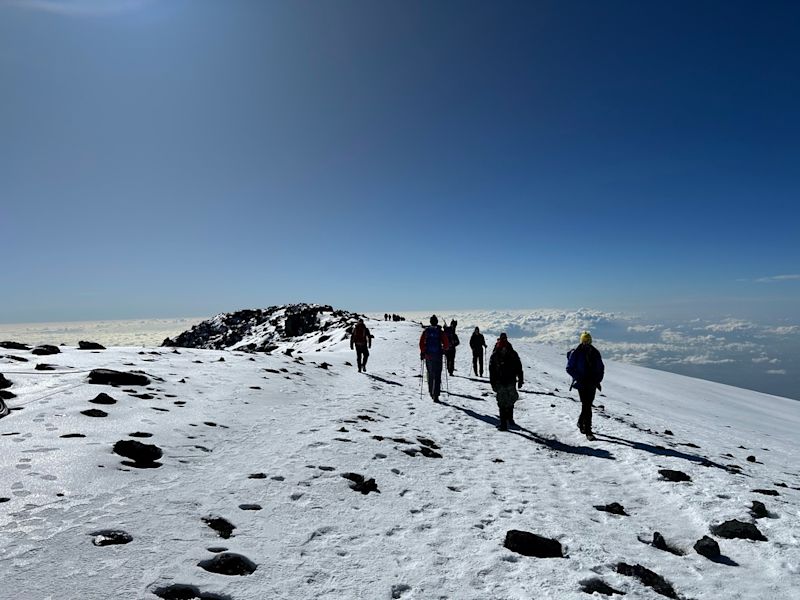Climbing Kilimanjaro and going on a safari in Tanzania is an adventure like no other. This journey combines the thrill of summiting Africa's highest peak with the excitement of exploring its breathtaking wildlife.
The Kilimanjaro trek offers stunning views and diverse landscapes. Meanwhile, a Tanzania safari immerses you in the vibrant ecosystems of its national parks.
In this guide, we will provide essential insights for planning your Kilimanjaro trek and safari experience. From routes to wildlife encounters, we've got you covered.
Understanding the Kilimanjaro trek
Trekkers on Kilimanjaro
The routes to the summit
Mount Kilimanjaro offers seven main routes to its summit, each varying in difficulty, scenery, and duration. The most popular routes include the Marangu, Machame, Lemosho, Rongai, and Northern Circuit routes. Each route presents distinct experiences, from the lush rainforests and moorlands to the stark alpine deserts and glaciers near the summit.
Marangu Route
Known as the "Coca-Cola" route, the Marangu Route is favoured for its hut accommodations and relatively gentle gradient. However, its popularity means it can be crowded, and its rapid ascent can lead to a higher incidence of altitude sickness.
Machame Route
Often called the "Whiskey" route, the Machame Route is renowned for its scenic beauty. It offers a diverse range of landscapes and a more gradual acclimatisation profile, making it a preferred choice for many trekkers seeking a more challenging yet rewarding experience.
Lemosho Route
The Lemosho Route is considered one of the most beautiful and less travelled paths. It offers an extended trek, allowing for better acclimatisation and increased chances of summit success. The trek begins in the western region and traverses through lush forests before joining the Machame Route.
Acclimatisation and preparation
Acclimatisation is critical for a successful climb. Trekkers are advised to follow the "climb high, sleep low" principle to minimise the risk of acute mountain sickness (AMS). Adequate preparation includes physical conditioning, securing necessary gear, and understanding the effects of high altitude.
The safari experience in Tanzania
The Great Migration is Tanzania's biggest safari drawcard
A journey through Tanzania's national parks
Tanzania is home to some of Africa's most iconic national parks, offering unparalleled wildlife viewing opportunities. A safari following a Kilimanjaro trek provides a perfect contrast to the high-altitude adventure with a chance to witness Africa's "Big Five" and other remarkable wildlife in their natural habitats.
Serengeti National Park
The Serengeti National Park is synonymous with the Great Migration, where millions of wildebeest and zebras traverse the plains in search of fresh grazing. This spectacle, combined with the park's abundant predator population, makes it a must-visit for any safari enthusiast.
Ngorongoro Crater
The Ngorongoro Crater, a UNESCO World Heritage Site, is a unique caldera filled with diverse wildlife. Visitors can expect to see elephants, lions, rhinos, and a plethora of bird species within the confines of this natural wonder.
Tarangire National Park
Known for its large elephant herds and ancient baobab trees, Tarangire National Park offers a more secluded safari experience. The park's varied landscape and seasonal wetlands attract a wide array of wildlife, including migratory species.
Planning your safari
Selecting the right safari itinerary involves considering factors such as the time of year, duration, and personal interests. Whether opting for a luxury lodge or a more rustic tented camp, each choice offers unique advantages and perspectives of the Tanzanian wilderness.
Combining the Kilimanjaro trek and safari
Logistics and timing
A combined Kilimanjaro trek and safari can be efficiently planned to maximise the experience of both adventures. Typically, the trek is completed first, allowing climbers to adjust to the altitude and exertion before relaxing on a leisurely safari tour.
The ideal time for this dual adventure is during Tanzania's dry seasons, from June to October and January to February. These periods offer optimal trekking conditions and excellent wildlife viewing opportunities.
Health and safety considerations
Both adventures require careful health and safety planning. For Kilimanjaro, this includes understanding altitude-related health issues, securing proper travel insurance, and ensuring vaccination requirements are met. On safari, awareness of wildlife safety and adherence to park regulations are paramount.
Practical tips for a successful adventure
The summit of Kilimanjaro has an arctic climate
Packing essentials
- For Kilimanjaro: Layered clothing for varying temperatures, sturdy hiking boots, a good-quality sleeping bag, and trekking poles. Additionally, consider packing a waterproof jacket, thermal gloves, and a hat to protect against the cold at higher altitudes. A hydration system or water bottles are also crucial to stay hydrated during the trek.
- For safari: Lightweight, neutral-coloured clothing, binoculars, a camera with a good zoom lens, and insect repellent. It's also wise to bring a wide-brimmed hat, sunscreen, and a refillable water bottle to stay hydrated while exploring the parks. A small backpack for day trips can be handy for carrying essentials.
Engaging a tour operator
Choosing a reputable tour operator is essential for a seamless experience. Look for operators that offer comprehensive packages, including licensed guides, porters, transportation, and accommodation. Verify their safety records and commitment to sustainable tourism practices. Reading reviews and testimonials from previous clients can provide valuable insights into the operator's reliability and quality of service. Additionally, inquire about their policies on responsible wildlife viewing and community engagement to ensure your safari experience is ethical and respectful.
Cultural considerations
The Maasai of northern Tanzania lead a very traditional lifestyle
Tanzania is a country rich in cultural heritage. Engaging with local communities respectfully, learning a few Swahili phrases, and understanding local customs can enhance the travel experience and foster meaningful interactions. Consider participating in cultural tours or visiting local markets to gain a deeper appreciation of Tanzanian traditions. Respecting local dress codes, especially in rural areas, and being mindful of photography etiquette can also contribute to positive exchanges with the locals.
Health and safety precautions
Before embarking on your adventure, ensure you are up-to-date on vaccinations and carry necessary medications, including altitude sickness prevention drugs. It's advisable to consult with a travel health specialist to discuss any specific health concerns related to trekking and safari activities. Familiarise yourself with the symptoms of altitude sickness and know how to respond if you or a fellow trekker experiences them. On safari, always follow your guide's instructions regarding wildlife safety, and maintain a safe distance from animals to ensure both your safety and their well-being.
Environmental responsibility
As you embark on this incredible journey, remember to practice Leave No Trace principles. Dispose of waste properly, avoid disturbing wildlife, and stick to designated trails to minimise your impact on the environment. Supporting local conservation efforts and choosing eco-friendly accommodations can also contribute to the preservation of Tanzania's natural beauty for future generations.
Embarking on a journey to climb Kilimanjaro and go on a safari in Tanzania truly encapsulates the essence of the ultimate African adventure. This remarkable experience allows travellers to push their limits while navigating the majestic slopes of Africa’s highest peak, all while being surrounded by the stunning beauty and diverse wildlife of Tanzania’s national parks.
The blend of high-altitude trekking and exhilarating safari encounters creates a unique tapestry of experiences that few places on Earth can offer. From the breathtaking views atop Kilimanjaro to the unforgettable moments spent observing the Big Five in their natural habitat, this adventure is a celebration of nature’s grandeur and a testament to the spirit of exploration.
With careful planning and a sense of adventure, those who choose this journey will leave with memories to last a lifetime, having truly experienced the unparalleled wonders of East Africa. Don’t miss the chance to make this dream a reality—the ultimate African adventure awaits!







